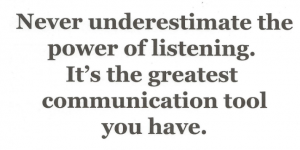Marketing in a Crisis: Stop, Think, Breathe
Marketing in a Crisis: Stop, Think, Breathe
When I was learning to scuba dive, one thing my instructor said about dealing with a crisis stuck with me: Stop (whatever you’re doing). Think (about the situation and your options). Breathe.
In scuba diving, it’s crucial not to panic when things go sideways. It can mean the difference between life and death. Hence, the guidance to stop, think, breathe. It makes it so much easier to act. And this is true no matter the crisis, which is why it has stuck with me—and why it was the first thing I thought of when I tuned into Social Media Examiner’s live chat on whether marketers should be marketing during the Covid-19 crisis.
I also thought of it during last Thursday’s #TwitterSmarter chat on how to be professional on X (formerly Twitter) during a crisis. The first question asked whether you should think about crisis management when building an X strategy. I must confess, I wondered if I was reading the question wrong, because any time you’re developing any kind of communication strategy, you should always think about crisis management. Why? Life happens, planning helps.
Planning for a crisis helps prevent panic communication or going radio silent or just doing stupid stuff. Your crisis management plan doesn’t have to be elaborate, and it most definitely should be nimble. How you respond to fraud, for example, is going to be very different than how you respond to a natural disaster or a pandemic. But a general approach to how your company will communicate during a crisis is key.
So, should you market during a crisis like Covid-19? If by marketing, you mean using it as an opportunity to sell more product—the answer is emphatically no! If what you mean is listening and helping, educating, informing, and/or entertaining—absolutely!
And should you think about crisis management when developing a communication strategy? Yes.
Whether your focus is social media, marketing, PR, or sales, you should have a policy in place governing communication, and it should include what to do in a crisis. And whatever your policy/plan, I recommend you stop, think, breathe, listen, and then act.
Stop
- Stop whatever you’re doing, whether it’s panicking or tweeting
- Look at your already-scheduled communications and assess whether they’re still relevant and appropriate—pull anything that isn’t both
But the above doesn’t mean go radio silent.
Think
- Remember and refer to your policy
- Assess the situation and determine your options
- Decide how you can best help
- Develop your plan and communicate it to all employees
Breathe
When people panic, they tend to hold their breath, which can be problematic if you’re scuba diving. So, in crisis management, breathe is a reminder not to panic.
In a scene from American President, Robin, the White House Press Secretary, said, “I think the important thing is not to make it look like we’re panicking.” To which President Shepherd replied, “See, and I think the important thing is actually not to be panicking.”
So, breathe deep and slow, and remember to think, listen, and then act.
Listen
The beauty of social media is it gives people a voice, which makes it easy to:
- See what your audience wants and needs
- Stay informed
If you really listen and pay attention, you’ll learn what content is best to share on social media or via email and elsewhere.
Act (Help, Educate, Inform, Entertain)
Some of the biggest mistakes marketers make when reacting to a crisis are:
- Capitalizing on it
- Panicking about it
- Ignoring it
- Hyper-focusing on it
The first mistake is wrong and will likely end in an epic fail. Just don’t do it.
The other three are completely understandable. They’re also avoidable by simply taking a cue from social media—or at least what the focus of social media should always be: helping, educating, informing, and entertaining our audiences.
If your social media strategy is to regularly share content that helps or entertains your audience, it makes it infinitely easier to act during a crisis, as it doesn’t require a complete rejiggering of your plan, just a modification to match the current circumstances. And trust me, you’ll still sell.
I’ve shared that philosophy with my students since my first social media class in 2011, so I loved hearing about Marcus Sheridan’s “revolutionary marketing strategy”: answering customers’ questions at the first Social Media Marketing World in 2013. Internally, I was shouting “Yes [insert fist pump]!” True, Marcus runs a small business, but it doesn’t matter if you have a 20-person pool business or you’re at a fortune 100 company with 100,000+ employees, answering customers’ questions (i.e. helping, educating, informing) will help you sell.
So, what does that translate to during a crisis? Some of what you post will be about the crisis, some won’t—and that’s okay!
- Listen to your audience and use what you learn to drive your content
- Don’t be afraid to ask your audience what they’d like to see from you or what would be helpful
- Be open and honest
- Alleviate fears where you can
- Answer their questions
- Help them do their job
- Use humor as appropriate for the situation and your brand
Using Covid-19 as an example, while many people aren’t working, there are still a lot who are, because their companies are either essential businesses or have work-from-home capabilities in place. If your audience falls into either category, they’re still going to need your help. Focus on that, but it doesn’t have to be all about the crisis or working from home. Think about all the customer questions you’ve received. Each one is a blog post, X tip, how-to video, etc.
We’re all inundated with Covid-19 talk—everywhere. It’s both overwhelming and depressing. As a business, you don’t want to focus on it nor ignore it. Both can make you appear tone deaf. It’s also hard to live in crisis mode 24×7. People want to escape it where they can. If you can help them do that, then do. So, if appropriate for your brand (and the crisis at hand), don’t forget humor and stories.
In that spirit of helping, make sure to check out @Hootsuite’s 10 tips for communicating on social media during a crisis or emergency. It’s a good list—short and sweet!
And in the spirit of humor and stories, I want to close with a story that could happen to any of us working from home, which had me laughing (because it so could have been me) and applauding (for how the #PotatoBoss rolled with it): This Woman Accidentally Turned Herself Into A Potato For A Video Meeting And Couldn’t Figure Out How To Fix It.






